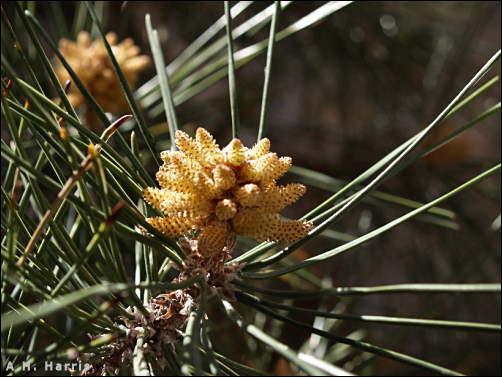

The conifers consist of a large group of plants named after the seed-bearing cones that they produce. Most of us easily recognize these reproductive structures, just as many inhabitants of the Southwest revel in the pinyon nuts produced by several species of pines. As might be expected, since they produce seeds, these large cones are concerned solely with the female reproductive system. We tend to ignore, or possibly not even recognize, the male reproductive system structures. These are the small, somewhat cone-shaped structures that produce the pollen. Without pollen to see to the fertilization of the female parts, the familiar cones would bear no seeds at all.
Look close at your favorite conifer in late winter or spring, and
you'll see miniature cones toward the ends of branches; cones that produce copious
minute, yellow grains of pollen. Indeed, in a good year, you may even see drifts of
yellow collecting in eddies of our infamous spring winds. Just because the female cone
is the showy one is no reason to neglect the inconspicuous, but essential, modest male
cone.

Contributor: Arthur H. Harris, Laboratory for Environmental Biology, Centennial Museum, University of Texas at El Paso.
Desert Diary is a joint production of the Centennial Museum and KTEP National Public Radio at the University of Texas at El Paso.

Foliage and male cones of a pine (Pinus sp.), University of Texas at El Paso campus, 12 March 2005. Image by A.H. Harris.